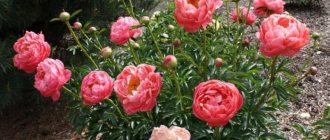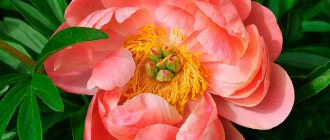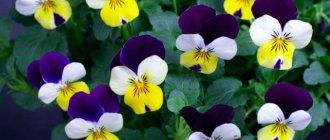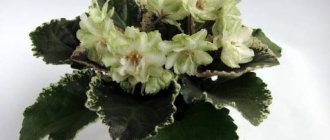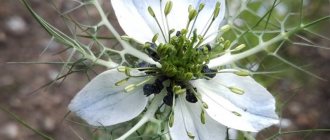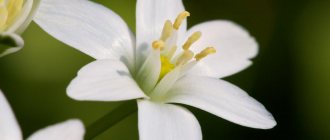Characteristics and description of the variety with photos
Coral Sunset was bred in 1965 by the joint efforts of breeders S. Wissing (USA) and L. Cousins (Canada). Thanks to its spectacular buds and sophisticated aroma, coral peony has rapidly gained popularity among flower growers in America and Europe. In Russia, it is grown in the south, in the middle zone and some northern regions. The main requirement is that the summer average daily temperature does not fall below 10*C.
Being a hybrid, Coral Sunset successfully combines the features of herbaceous and tree peonies. The plant is a tall, leafy bush with large buds and strong stems.
Hive parameters:
- height – 90-110 cm;
- crown volume – 80-90 cm;
- bud diameter – 15-20 cm.
The hallmark of the hybrid is fragrant semi-double buds with petals arranged in 5-7 rows. In the first days of flowering, the petals are painted in pastel colors with a slight admixture of pink, but after the bud fully opens, they acquire an expressive coral hue. Regardless of the growth stage, the core is always lighter than the tips. The petals are curved inside the bud and partially cover the core of the flower.
Peculiarity! Lush flowering of peony is observed only from the third year of life. It begins in the first days of June and continues until mid-July.
Use Cases
A noble plant will favorably emphasize the beauty of a flower bed or garden plot if you place it in group compositions with other peonies or other flowering perennials that have the same shoot height as our hero. The variety is appropriate in mixborders, in ensembles with decorative foliage crops. It can also be planted as a single bush. Coral sunset goes well with low-growing conifers and evergreens, as well as roses and clematis. Shoots with coral flowers make delightful bouquets.
Even in Ancient Greece, peonies were used to create beautiful compositions in royal gardens. Today, these beauties can be found not only in parks or greenhouses, but also in many garden plots. Coral peonies have earned particular popularity.
How to grow Coral Sunset peony?
Coral peonies are unpretentious and frost-resistant plants. With proper care, they do not cause trouble to the gardener and hardly get sick.
But you can achieve bright and lush flowering only if you follow the basic principles of cultivation:
- choosing a suitable place on light soil;
- timely watering and balanced fertilizing;
- high-quality preparation for wintering.
Landing location
Coral Sunset loves sun and space. Therefore, the landing site must satisfy the following criteria:
- Solarization. The area should be well lit for most of the day (at least 12 hours). Shading negatively affects the quality of peony flowering.
- Wind protection. The location must be protected from gusty squalls. Planting is allowed near buildings and hedges located on the windy side. In this case, the distance to the nearest building must be at least 2 meters.
- Distance from trees and bushes. Peony has a well-branched root system. For normal growing season, an appropriate distance must be maintained to the nearest competitive plants.
- No spring flooding. If there is water on the flowerbed during March-April, the flowers will begin to suffer from root rot.
Soil requirements
Peony prefers light soil - ideally loam or sandy loam. If the soil on the site is heavy, then the top layer of soil will have to be replaced before planting.
To do this, remove the top 50 cm of soil and fill the resulting depression with a specially prepared soil mixture:
- 2 parts of turf;
- 2 parts vermicompost;
- 1 part sand.
The soil should be slightly acidic or neutral. Optimal pH level = 6.5.
Attention! The acidity of the soil is reduced with the help of lime fertilizers, and increased by the application of manure and vermicompost.
When to plant a plant?
Coral Sunset is planted in spring or early fall. After spring planting, a young and weak plant goes through a sweltering period of summer heat, which is why it often gets sick and develops poorly. Therefore, planting in September is considered preferable.
The landing is carried out according to the following scheme:
- Dig planting holes about 50 cm deep at intervals of about 1 meter. If the flowerbed is located near groundwater, deepen the hole to 70 cm and fill the bottom with a mixture of sand and gravel.
- The root collar is positioned so that the upper bud does not reach the edge of the hole by 5 cm.
- The roots of the plant are sprinkled with sifted soil and compacted to eliminate air pockets.
- A border 5 cm high is formed around the planted peony, after which the seedling is watered abundantly.
Description
Peony is a perennial plant. All their types can be divided into several subspecies: these are herbaceous, semi-shrub and bush peonies. However, they all have a well-developed root system and dense stems, which can reach a height of up to one meter.
Peony leaves have a carved shape and a green color, which in some varieties changes over time. In some cases, you can also find bluish leaves. The flowers are most often double or semi-double and appear as large multi-colored buds. They reach 24 centimeters in diameter. The seeds of this plant are quite large, oblong or round in shape.
Flower care: basic rules
Care is performed according to the following rules:
- The top layer of soil around the plant should always remain loose. This is necessary to maintain air exchange in the soil. Loosening is carried out in the interval between waterings, preventing the formation of a hard earthen crust.
- To speed up the growing season, growth stimulants should be used: Epin, Zircon, Kornevin. The preparations are diluted in water according to the instructions and applied after watering.
- At the end of flowering, it is advisable to apply phosphorus fertilizers to replenish the resulting deficiency.
- Until the age of 3, it is necessary to stimulate the growth of the root system, limiting flowering. To do this, during the formation of the ovaries, all the buds are pinched off. If the buds are left, the peony will not produce maximum flowering at maturity.
Necessary feeding and fertilizers
Plants that have passed the three-year mark require mandatory feeding. Often, complex formulations are used as fertilizers in an amount of 80 g for one season. The first feeding of peonies is carried out in early spring, and fertilizers are applied to a pre-prepared groove around the bush.
The second application of fertilizers is carried out during the budding period, and the third - a couple of weeks after the end of flowering. A single dose should be about 26 g, which is approximately 1 tbsp. l. for a 10 liter bucket of water.
Preparing for winter
Coral Sunset is a winter-hardy hybrid. It tolerates frost well in the presence of snow cover. For successful wintering, plants carry out preparatory measures:
- Feed plants with phosphorus after flowering.
- Mulch the flowerbed in the autumn.
- Carry out autumn pruning.
Attention! In severe frosts (below -10*C), peonies should be covered with burlap, creating a kind of protective hut.
Is mulching necessary?
In the fall, after the plant enters the dormant phase, the flowerbed is mulched. The following is used as mulch:
- crushed straw;
- sawdust;
- pine needles;
- dried grass.
A 15 cm layer of mulch prevents deep freezing of the soil in winter. In early spring, the mulch is removed so that it does not interfere with the hatching of young shoots.
Bush pruning
Timely pruning significantly increases the plant’s chances of successful wintering. The entire above-ground part of the bush must be removed, excluding growth shoots above the buds, the length of which does not exceed 5 cm. All stems are shortened to “stumps” 5-10 cm long. Pruning at the root is strictly not recommended - this can injure the root system.
Other trimming features:
- early pruning can disrupt the process of photosynthesis and weaken the plant;
- the optimal time for pruning is late autumn with consistently cold weather (in the middle zone this period occurs in the first half of November, in northern latitudes - the end of October);
- the condition of the plant (the presence of diseases or pest attacks) should not affect the timing of pruning.
Proper watering
The soil must be kept moist at all times. Watering is especially important in the spring, when the processes of budding and flowering occur, and in the fall during the formation of flower buds. When watering, 2-3 buckets of water are needed per plant to irrigate the deep layers of soil where the root system is located.
Attention. Young flowers require infrequent, but abundant watering. The main condition in this matter is to prevent the soil from drying out.
Peony propagation Sunset coral
Peony is propagated in one of three ways:
- Seeds. Used only for breeding purposes.
- Dividing the bush. The simplest method. A bush 3-4 years old is dug up, cleared of soil, washed with water and lowered into the cellar for 3-6 hours. This is necessary to soften the roots. Then, using a knife, the bush is divided into seedlings with buds and lateral shoots. The cut areas are treated with garden varnish.
- By layering. A formwork in the form of a box is installed around the buds of an adult bush and filled with compost. In autumn, the formwork is removed and the seedlings are transferred to a new location.
What varieties are there?
The flowering period of peonies is determined by the formation of large buds; all plant varieties bloom at approximately the same time, and then an amazing aroma spreads throughout the entire holiday village. Gardeners note that each variety of peonies has its own aroma, but, in general, it is a single smell that will be remembered for a lifetime.
Pink
Most of all, gardeners value peonies of the Pink variety. This is an intraspecific variety bred by American breeders. Its inflorescences are anemoid-shaped and its leaves are terry. The flowers are light, coral pink. A fully opened bud reaches an average diameter of up to 12 centimeters. The bush grows up to 70 centimeters.
The main significance of this species is that it has strong stems that do not break in the wind or when cut into bouquets. The leaf color is light green. This is a mid-late variety, its aroma is weakly expressed.
Hawaiian
Peonies of the Hawaiian variety have only positive reviews from gardeners. It is classified as a universally herbaceous plant; it blooms once, but profusely. It is an intraspecific variety of Pink Hawaiian; its bush reaches a meter in height. The opened bud has a diameter of 20 centimeters. The petals are semi-double, the main color is milky, apricot-colored. In the center the inflorescence is decorated with stamens of a bright creamy hue. Hawaiian peonies smell like fresh hay. Gardeners highly value this variety, noting its good resistance to winter cold and early flowering.
Beach
Characteristics of the Beach variety are delicate coral tones. The variety is also milky-flowering. The height of the bush is at least 90 centimeters. The leaves along the entire stem are dark green in color. The open flower reaches 17 centimeters.
This variety is distinguished by a flower in the shape of a water lotus. It begins to bloom early and blooms for a long time. The petals of the flower are semi-double, decorated with a core of bright yellow tset. Valued by gardeners for its frost resistance and drought resistance.
Fey
The Fairy peony variety is a hybrid of several species. Brought out by US breeders in 1972. It is a low shrub plant, growing only up to 75 centimeters. The flowers are round in shape and have semi-double petals. The main color of Fay is pink, with a pronounced coral tone. The petals are darker in color towards the center of the flower. The opened bud grows to only 16 centimeters in diameter.
Fey has a delicate aroma that gives the bouquet real elegance. The leaves are light green, carved, similar to decorative ones. Fairies begin to bloom very early, which attracts all gardeners.
Coral Sunset
Beginning gardeners love the Coral Sunset variety. The plant is perennial, the stems are tall, straight, the bush is compact, up to 90 centimeters high. Cup-shaped flower, semi-double petals. The diameter of the flowers is up to 20 centimeters. The color of the flower is unusual - peach, interspersed with pink and red tones. As the petals fade, they turn yellow.
See also
Causes and treatment of peony diseases, best pest control measuresRead
All shades of Sunset harmonize perfectly with bright green foliage. The leaves retain their color throughout the season and look decorative. The flowers have a pleasant aroma. This type of peony is a participant in many exhibitions, competitions, and winner of various awards.
Supreme
Gardeners were pleased with the appearance of the Supreme peony variety. This is a rare hybrid variety that is distinguished by its spectacular appearance. The shrub variety is distinguished by powerful stems with rich green leaves.
The height of the bush reaches 90 centimeters.
Supreme flowers are cup-shaped, semi-double petals of an interesting salmon color produce a coral-pink inflorescence. When ripe, the petals lighten to a pearlescent beige hue. The diameter of the flowers is up to 20 centimeters. Flowering period is mid-early.
Coral Charm
The herbaceous bush Coral Charm decorates the dacha. Its difference is in the original coloring of the flowers. As it begins to bloom, the flower turns dark pink. As the petals bloom, they change color to light coral, with a light border appearing along their edges. Flowering ends with another transformation: the petals acquire a yellow color. Throughout the flowering period, the petals are semi-double and large.
The size of the blooming flower reaches 20 centimeters in diameter. The structure of the bud is interesting: it consists of 8 rows of petals. This makes the flower incredibly lush. Dark green foliage and reddish stems add luxury to the bouquet. At the same time, strong stems do not break in bouquets. The bush grows at least a meter. Peony Coral Charm is an early blooming variety. Its beauty has delighted gardeners since the beginning of summer.
En Gold
The En Gold peony delights, it has an interesting color and large flowers, decorated with fluffy stamens of a delicate coral shade. This variety blooms early - from March. The inflorescences are cup-shaped and reach 20 centimeters when fully expanded. They are distinguished by a rich, sweet aroma. The peony blooms for a long time, densely; the inflorescences remain in their structure for about two weeks. The height of the bush is up to 90 centimeters. There are many leaves, they are distinguished by narrow lobes and dark green color.
Magic
The variety was recently bred and amazes with its colorful flowers. Its flowers are three-rowed, with semi-double petals of bright color. Their circumference reaches 15 centimeters, the middle is decorated with bright yellow stamens. A compact and low bush grows up to 70 centimeters. The stems are strong, stand straight, covered with leaves of a soft green tone. This is an early flowering variety - the first buds appear in April.
Cora Louise
The amazing variety Cora Louise is an intersectional hybrid, it is a bush that grows up to a meter, its stems are strong, densely covered with decorative leaves of a dark green hue. The color of the leaves lasts until the autumn cold. The flowers are large, up to 25 centimeters in diameter, the petals are semi-double.
The color of the flower is interesting - it varies from white-pink, white-cream, to pale lilac. At the base, the petals are colored with a lavender-violet tint, which gives an expressive color to the middle of the flower. The bright yellow stamens add to the charm. Their aroma is light and sweet. Cora Louise is a medium flowering variety.
Topeka Coral
A hybrid shrub that grows up to 70 centimeters, its stems are strong and covered with large green foliage. The inflorescences are beautifully spherical in shape, with double coral-pink petals. The maximum color saturation of the flower is achieved at full bloom, then it brightens and takes on a peach hue. In terms of flowering, the hybrid variety is early and medium. The aroma has a soft musky aftertaste. Topeka Coral flowers are large, perfectly composed, and fully packed with petals.
Cora Louis
The flowering of the hybrid variety Cora Louis, similar to mountain peonies, is delightful. It blooms early - from April, with large white-pink flowers, with purple and burgundy stains at the base of the petals. The middle of the flower is decorated with bright yellow stamens. The opened flower reaches a diameter of 25 centimeters. The bush blooms for 2-4 weeks and reaches a height of 90 centimeters. The lacy foliage retains a rich green color until the autumn cold, then the color turns crimson.
Queen
A herbaceous variety with a closed root system grows up to 90 centimeters.
The flower is filled with double petals of interesting multi-colored colors - they are white-cream on the outside, yellow on the inside, and pale and pinkish in the middle. The buds are located on top of strong stems and bloom early.
Gardeners know! The variety of varieties allows you to choose any according to your taste, but each variety requires its own care.
Diseases and pests
Coral Sunset peonies have strong immunity and get sick only if the rules of agricultural technology are not followed. Flower diseases can affect:
- gray rot;
- powdery mildew;
- ring mosaic;
- leaf deformation.
Of the pests, peonies are most often attacked by nematodes, green bronze and kuzka. To prevent diseases and timely eliminate pests, it is recommended to regularly inspect the above-ground parts of the bushes. Periodic treatments with Fitosporin will help to avoid fungal diseases. Insecticidal preparations are used to control pests.
Rate this post
Peonies after flowering
At the end of flowering, it is also necessary to carry out some procedures. This will help the plant prepare for winter and survive this period painlessly.
If necessary, peony transplantation should be carried out at the end of August - beginning of September. It is impossible to delay the deadlines, since the plant will not have time to fully take root before the arrival of cold weather.
To do this, you need to dig up a bush. Then clean the roots from the soil and rinse well so that the recovery buds are clearly visible. After this, keep the plant in a shaded place for 2-3 hours - this will improve the process of cell division. Then carry out the landing according to the standard scheme.
The Coral Sunset peony needs to be pruned in October. The shoots should be cut at a height of 2-3 cm. The plant does not need formative pruning.
Preparing for winter
Only young peony seedlings need to be covered for the winter. To do this, you can use mulch from humus or peat, as well as spruce branches.
Important! Adult Coral Sunset peony bushes do not need insulation for the winter.
The cover must be removed in early spring to prevent the restoration buds from drying out.
Peony Pink Hawaiian Coral - what kind of variety is it?
The variety received the American Peony Society Gold Medal award in 2000 and the American Peony Society Award of Landscape Merit in 2009. Frost-resistant, can grow in climate zones with temperatures of -45 ℃. Detailed description of the variety:
- Perennial bush.
- Semidouble.
- Bush height 60-90 cm.
- The stems are strong, there is only one flower per shoot.
- One-time flowering.
- Flower diameter is up to 16-20 cm.
- The color of the outer petals is coral, pink, light pink, and apricot when fully bloomed.
- The petals in the center are creamy yellow or cream in color. Anthers golden, yellow.
- The aroma is sweet, soft, and may smell like rotten hay.
- Early flowering variety.
Pink Hawaiian Coral peony flower has a size of up to 16-20 centimeters
Advantages and disadvantages of the variety
Peony variety Pink Hawaiian Coral has large flowers with a diameter of 16-20 cm. It blooms early and very profusely. The bush has tall, strong stems, does not require mechanical support, and is good for cutting. The variety is frost-resistant and has reliable inheritance of traits during propagation.
It may have an unpleasant flower smell and requires deep tillage and constant qualified supervision. If poorly maintained after flowering, it is not aesthetically pleasing.
Pink Hawaiian coral peony blooms profusely
Using peony in landscape design
Pink Hawaii Coral peony has a fairly tall growth and large, abundant flowers. You need to carefully choose a place to place it and think about the neighborhood. To decorate the territory, plants are planted in groups.
By combining Pink Hawaiian Coral peony with other varieties you can achieve long flowering. During this period, it will add volume and splendor to the flower arrangement. In combination with late-flowering varieties of the same color scheme, it makes it easier to build a long-term composition.
On a note! The variety looks great against the backdrop of shrubs and trees, and irises, bells, and decorative onions will fit perfectly in front of it.
Features of coral peonies
Coral peonies have powerful, strong peduncles
Most gardens grow ordinary herbaceous or tree peonies with white, burgundy or pink flower colors, but there are unique hybrid varieties with coral shades of petals. Large buds of double, semi-double or single structure, bright at the beginning of flowering, but over time fade to apricot, cream and white tones. Coral peonies do not require garter; they grow well during the growing season, forming more than a dozen stems per year. Hybrid varieties are hardier than ordinary varieties, tolerate cold and heat, and are less susceptible to all kinds of diseases.
Coral peonies have thick lacy leaves and powerful stems. They combine the characteristic features of tree and herbaceous species. In autumn, all leaves and shoots are cut off. In areas with unfavorable and cool weather in the summer, it is necessary to carry out preventive treatment against fungal diseases.
How Coral peonies bloom
Most coral peonies have a not very pleasant faint aroma, so they are rarely cut into bouquets, being used more in garden decoration. For abundant and lush flowering, they require timely feeding and treatment against diseases.
Advice! To preserve the bright coral color of flowers for a long time, they can be planted in a place where there is afternoon shade, then they will not fade in the sun.
What to do if the peony does not bloom?
Let's look at the most common mistakes in planting and caring for peonies that prevent the crop from blooming:
- unfavorable place for planting (shade, more powerful plants, buildings, high groundwater nearby) - needs to be replanted;
- the old bush has exhausted its life resource - divide and plant again;
- incorrect division - too few roots to grow greenery and buds;
- planting too deep or shallow - dig up the bush and replant it;
- kidneys are damaged by frost - you will have to wait until next year;
- excessive use of nitrogen fertilizers - the bush grows green mass, there are no buds - fertilize with potassium and phosphorus fertilizers;
- poor care (lack of fertilizing, poor watering) in the previous year - the peony did not have enough strength to set buds;
- The green part was cut off early, the bush did not stock up on nutrients.
Peonies also do not produce buds when the soil is highly acidic (a pH greater than 6 is required) or the bush is damaged by fungal infections.
Propagation by seeds
Most gardeners do not use seeds to propagate Paeonia Pink Hawaiian Coral. Seedlings obtained after seed germination do not have the qualities endowed with the parent plants. But if you still have the task of growing a seedling from seeds that have a beautiful name, consonant with the Pacific coral island, then first you need to purchase high-quality seeds of these peonies and check their germination.
Then the seeds are treated with a fungicide or simple pale pink potassium permanganate, washed in running water, dried and placed in flower pots with a soil substrate of neutral acidity, buried 5 cm. This is done in August-September, approximately 30 days before the onset of cold weather. Pots are buried in the garden for the winter.
Note! In autumn, seedlings are transplanted from flower pots to a flower bed.
Peony Rosea Plena (Paeonia Rosea Plena) in the garden plot
This method is used very rarely due to the fact that plants grown from seeds have to wait at least 4 years for flowering. In addition, sowing and further caring for peony seedlings require certain knowledge and effort.
READ MORE: Peonies Diana Parks 10 photos description of the flower, features of its cultivation
Peonies grown from seeds do not inherit all the qualities of the mother plant. For this reason, the use of the method is relevant only when carrying out breeding work. In this case, artificial pollination is carried out between specially selected specimens to obtain seed material.
This method is used very rarely due to the fact that plants grown from seeds have to wait at least 4 years for flowering. In addition, sowing and further caring for peony seedlings require certain knowledge and effort.
Peonies grown from seeds do not inherit all the qualities of the mother plant. For this reason, the use of the method is relevant only when carrying out breeding work. In this case, artificial pollination is carried out between specially selected specimens to obtain seed material.

